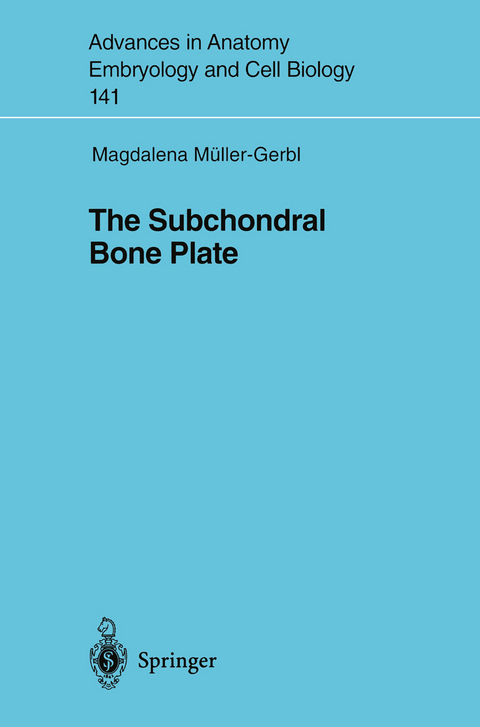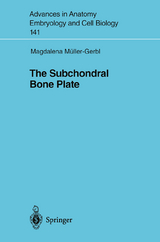The Subchondral Bone Plate
Springer Berlin (Verlag)
978-3-540-63673-1 (ISBN)
1 Introduction (Review of Literature).- 1.1 Preliminary Remarks.- 1.2 General Mechanisms for the Regulation of the Morphology of Bone Tissue.- 1.3 Morphology of the Subchondral Bone.- 1.4 Function of the Subchondral Bone Plate.- 1.5 Possible Pathomechanisms Leading to Osteoarthritic Changes.- 1.6 Factors Regulating the Remodeling of the Subchondral Bone.- 1.7 The Aims of this Investigation.- 2 Materials.- 2.1 Material for the Validation of CT-OAM.- 2.2 Materials Used for CT-OAM.- 3 Methods.- 3.1 X-ray Densitometry.- 3.2 CT OAM Used to Demonstrate the Patterns of Subchondral Mineralization in the Living Subject.- 3.3 The Production of Secondary Sections.- 3.4 Dual-energy QCT with basis material decomposition.- 3.5 Methods of Achieving Standardized Evaluation and Quantification of the Mineralization Patterns.- 4 Validation of CT OAM.- 4.1 Comparison with Conventional Procedures.- 4.2 Dependence of the Absorption Value on the Calcium Concentration.- 4.3 The Use of CT OAM in Connection With Sections Cut at Other Angles.- 5 Mineralization Patterns in Healthy Subjects.- 5.1 Vertebral Column (Lumbar Region).- 5.2 Shoulder Joint.- 5.3 Elbow Joint.- 5.4 Radiocarpal Joint.- 5.5 Hip Joint.- 5.6 Femorotibial Joint.- 5.7 Femoropatellar Joint.- 5.8 Ankle Joint.- 6 Pathological Mineralization Patterns.- 6.1 Vertebral Column.- 6.2 Shoulder Joint.- 6.3 Radiocarpal Joint.- 6.4 Hip Joint.- 6.5 Femorotibial Joint.- 6.6 Femoropatellar Joint.- 7 Factors Influencing the Development of Normal Patterns of Mineralization.- 7.1 The Shape of the Joint Surfaces.- 8 Factors Influencing the Development of Pathological Patterns of Mineralization.- 8.1 Abnormal Geometrical Relationships.- 8.2 Changes in the Magnitude of the Joint Reaction Force.- 8.3 Changes in Size and Position of the Contact Surfaces.- 8.4 Changes in the Penetration Point of the Joint Reaction Force.- 8.5 The Temporal Course of the Changes.- 9 Possible Clinical Application of CT OAM.- 9.1 Basic Clinical Research.- 9.2 Diagnosis.- 9.3 Following the Progress of Treatment.- 10 Summary.- References.
| Erscheint lt. Verlag | 19.2.1998 |
|---|---|
| Reihe/Serie | Advances in Anatomy, Embryology and Cell Biology |
| Zusatzinfo | XI, 134 p. 77 illus., 1 illus. in color. |
| Verlagsort | Berlin |
| Sprache | englisch |
| Maße | 155 x 235 mm |
| Gewicht | 280 g |
| Themenwelt | Studium ► 1. Studienabschnitt (Vorklinik) ► Anatomie / Neuroanatomie |
| Studium ► 1. Studienabschnitt (Vorklinik) ► Histologie / Embryologie | |
| Studium ► 1. Studienabschnitt (Vorklinik) ► Physiologie | |
| Naturwissenschaften ► Biologie | |
| Schlagworte | Bone • Bone tissue • chondromalacia patellae • Computed tomography (CT) • Diagnosis • mineralization • osteoabsorptiometry • Osteoarthritis • tissue • x-ray densitometry |
| ISBN-10 | 3-540-63673-0 / 3540636730 |
| ISBN-13 | 978-3-540-63673-1 / 9783540636731 |
| Zustand | Neuware |
| Haben Sie eine Frage zum Produkt? |
aus dem Bereich




